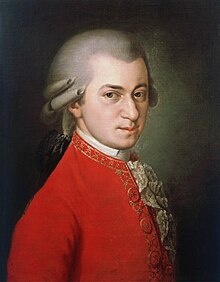Symphony No. 5 (Mozart)

The Symphony No. 5 in B♭ major, K. 22, was composed by Wolfgang Amadeus Mozart in The Hague in December 1765, at the age of nine, while he was on his musical tour of Western Europe.[1] Mozart fell seriously ill during his stay in The Hague, and he wrote that composition probably while he was convalescing from his illness.[1]
Structure[]
The symphony is scored for two oboes, two horns and strings.
The form is that of a three-movement Italian overture:
- Allegro, 4
4 - Andante, 2
4 - Allegro molto, 3
8
All three movements are colored especially prominently by horns. A rousing first movement in the key of B♭ major opens the symphony, followed by a more solemn, mournful movement in the relative key of G minor. A short, boisterous finale closes the work. The opening theme to the finale is borrowed from the finale to keyboard concerto by Johann Christian Bach whom Mozart had met the previous year in London.[2] The same theme would also appear in a much later, more mature work of Mozart's: the act 2 finale of his 1786 opera buffa, Le nozze di Figaro, K. 492.[3]
References[]
- ^ Jump up to: a b Mozart, Wolfgang Amadeus (2005). Die Sinfonien I. Translated by Robinson, J. Branford. Kassel: Bärenreiter-Verlag. p. X. ISMN M-006-20466-3
- ^ Brown, A. Peter, The Symphonic Repertoire (Volume 2). Indiana University Press (ISBN 025333487X), pp. 347–348 (2002).
- ^ Sadie, Stanley. Mozart: The Early Years, 1756–1781, p. 105, New York: W. W. Norton (2006) ISBN 0-393-06112-4.
External links[]
- Symphony in B-flat K. 22: Score and critical report (in German) in the Neue Mozart-Ausgabe
- Symphony No. 5: Scores at the International Music Score Library Project
- Symphonies by Wolfgang Amadeus Mozart
- 1765 compositions
- Compositions in B-flat major

